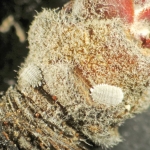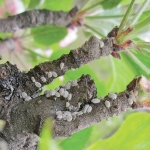A team of scientists at Washington State University is hoping to help orchardists identify and control little cherry disease, which has become a problem in all cherry growing areas of central Washington in recent years.
Trees infected with the virus produce small, poorly colored cherries that lack sugar and have a bitter flavor.
Three pathogens are associated with little cherry disease: Western X, little cherry virus strain 1, and little cherry virus strain 2. Little cherry virus 2 is the strain most commonly found in north central Washington and is the more severe of the two. Western X seems to be the predominant pathogen in the Tri Cities area.
During the North Central Washington Stone Fruit Day held in Wenatchee in January, postdoctoral research assistant Dr. Andrea Bixby-Brosi outlined a three-year research project that WSU launched last year with funding from the Washington Tree Fruit Research Commission.
The project also involves entomologist Dr. Elizabeth Beers, virologist Dr. Ken Eastwell, agricultural economist Dr. Karina Gallardo, and extension specialist Tim Smith.
Brosi said the fast-spreading disease can have major economic consequences because of lost revenue on fruit that has to be left unpicked or is rejected at the packing house and the cost of removing trees, if not entire orchards.
Symptoms of little cherry disease can vary depending on the cultivar and the weather. Some infected trees don’t show any symptoms, yet serve as a reservoir of the disease, so it is difficult to diagnose visually.
Because the three diseases have different vectors, it is important for growers to know what virus (little cherry 1, 2, or Western X) they are dealing with.
Diagnosis
Eastwell and his colleagues at WSU in Prosser use molecular analysis (reverse transcription polymerase chain reaction) to identify the virus.
Though this method is reliable, it is expensive and time-consuming, so Eastwell’s team worked with the private company Agdia and developed a quick diagnostic kit for growers that uses RPA (recombinase polymerase amplification) to test leaf sap for little cherry virus 2.
However, when tested in 2014, the kit did not give true results, Bixby said. Retesting of the same leaf samples with RT-PCR showed that the kit tended to give false negatives, particularly when used in early summer.
When used later in the year, in August or September, it gave more accurate results. Eastwell hopes to address the problems this year. He is also working to develop quick tests that growers can use to test for Western X and little cherry virus 1.
Samples analyzed last year showed that most infections were little cherry virus 2, though a surprising number turned out to be Western X disease, which seems to be making a resurgence in the northern half of the state.
Little cherry virus 1 was never found alone, but only in combination with one of the two other viruses, Brosi reported. The kit, designed to pick up little cherry virus 2, cannot detect when Western X is present.
Vectors
Little cherry virus 2 is spread by mealybugs, as well as by grafting. There is no evidence the virus is spread by pruning tools. Mountain leafhoppers are vectors of Western X, but vectors of little cherry virus 1 have not been identified.
Initially, it was thought that the apple mealybug (Phenacoccus aceris) was the culprit, but two years ago scientists were surprised to find that the grape mealybug (Pseudococcus maritimus) is also a vector.
Researchers are looking at how to control mealybugs in cherry orchards in order to stop the spread of the disease. Grape mealybug, a common pear pest in Washington, is not normally controlled in cherry orchards because it doesn’t affect the crop.
Little is known about the apple mealybug in Washington State. The pest is thought to have originated in Europe and has a wide host range including nut and ornamental trees as well as many types of fruit. Brosi said she is using an apple mealybug infestation at a WSU research orchard to learn more about the insect.
The apple and grape mealybugs have different lifecycles. Apple mealybug produces only one generation per year, whereas grape mealybug has at least two.
The adult mealybugs and their egg masses also differ in appearance.
Apple mealybugs begin to overwinter as second-instar nymphs and emerge in mid-March or April. They continue to develop into adults and, after mating, the females lay egg masses, from which crawlers emerge about June.
Mealybugs are challenging to control because they are protected by cottony secretions, Brosi said. And, if mealybug populations are low, the insects will be concentrated in the tops of the trees, where they are difficult to see.
“If you’re not on a ladder, you may not know you have it, and it may be transmitting the virus,” she warned.
Controls
Brosi and Beers tested several approaches to controlling the mealybugs: delayed dormant pesticide applications to intercept overwintering females; systemic petalfall applications to target crawlers; and foliar summer sprays timed when 70 percent of the crawlers are estimated to have emerged.
At the delayed-dormant stage, a combination of Lorsban (chlorpyrifos) and oil worked better than diazinon and oil or oil alone.
At petalfall, a soil drench using Admire (imidacloprid) or a foliar application of Ultor (spirotetramat) and oil reduced mealybug populations somewhat.
Admire, Actara (thiamethoxam), diazinon, and Centaur (buprofezin) were tested as direct foliar sprays. Brosi said the growth regulator Centaur, which prevents the mealybugs from molting to the next life stage, was not as effective as diazinon in controlling the insects and might work better at the delayed-dormant stage. They will test it again this year.
Also, this year, the researchers will explore organic control options, including repeated applications of horticultural and neem oils. There is also a parasitic Anagyrus wasp that might provide some control.
Brosi said researchers will also look at how long it takes for mealybugs to acquire the virus from infected trees and how infected mealybugs transmit little cherry disease to healthy trees.
They will sample orchards with a history of little cherry disease to see how far and how fast it spread and look at strategies for controlling the disease and stopping it from moving from orchard to orchard.
In addition, they will survey leafhoppers in cherry orchards infected with Western X disease. •








Leave A Comment